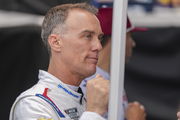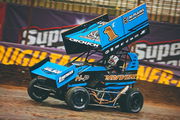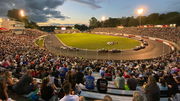
Imago
SONOMA, CA – JUNE 09: NASCAR, Motorsport, USA legend Richard Petty speaks to the media before the start of the Toyota/Save Mart 350 NASCAR Cup Series race on July 9, 2024, at Sonoma Raceway in Sonoma, CA. Photo by Matthew Bolt/Sonoma Raceway/Icon Sportswire AUTO: JUN 09 NASCAR Cup Series Toyota/Save Mart 350 EDITORIAL USE ONLY Icon240609789

Imago
SONOMA, CA – JUNE 09: NASCAR, Motorsport, USA legend Richard Petty speaks to the media before the start of the Toyota/Save Mart 350 NASCAR Cup Series race on July 9, 2024, at Sonoma Raceway in Sonoma, CA. Photo by Matthew Bolt/Sonoma Raceway/Icon Sportswire AUTO: JUN 09 NASCAR Cup Series Toyota/Save Mart 350 EDITORIAL USE ONLY Icon240609789
In NASCAR, it’s almost a tradition; drivers who come up short after a grueling night often point fingers at something to explain their frustrations. The recent race at Bristol Motor Speedway handed them plenty of ammunition, with the high-banked concrete oval living up to its reputation as a tire-killer. But this time, the degradation was jaw-dropping, thanks to Goodyear’s introduction of a softer right-side compound meant to shake up strategies. Hendrick Motorsports’ William Byron captured the raw anger on his radio, venting, “These, these are bad. These are sh-t,” as cords showed early and chaos ensued.
Watch What’s Trending Now!
Goodyear has been NASCAR’s tire supplier since 1954, becoming the exclusive provider in 1997 after an era of competitive “tire wars” with brands like Firestone and Hoosier. Yet with teams fixating on strategies rather than wheel-to-wheel battles, Richard Petty himself dived in to focus the situation. And this is not the first time Petty has spoken about drivers focusing more on complaining than actual racing. After last month’s Richmond Raceway, where a similar tire setup sparked debate, NASCAR Hall of Famer Petty weighed in, noting, “When they throwed the green flag, everybody said, ‘OK, what are we going to do on tires.’ Not, “What are we going to do racing each other?” But with Bristol amplifying the gripes, Petty, who notched three Bristol victories in his career spanning 1958 to 1992, couldn’t stay silent.
ADVERTISEMENT
Richard Petty weighs in on Goodyear tire gripes
In a recent video on the Petty Instagram, Richard Petty didn’t hold back, delivering a straightforward take on the ongoing tire drama that’s plagued recent short-track events. The 88-year-old legend, with 200 Cup Series wins under his belt, fired back at drivers’ complaints about Goodyear, framing them as whining rather than valid critiques. “I’m going to give you one man’s opinion of what I see. Goodyear’s spending millions of dollars to test these new tires because the drivers and NASCAR is asking them to help them with the car,” Petty said, highlighting how the push for innovation stems from the garage itself.
View this post on Instagram
He argues that constant tweaks create unpredictability, but ultimately, adaptation falls on the teams, echoing his own era when drivers dealt with whatever was thrown at them without the same level of outcry. Petty’s pointed words stem from frustration over how tire management has overshadowed pure racing, a sentiment he voiced after Richmond, where fall-off turned the event into a strategy puzzle. At Bristol, Goodyear aimed to boost wear with that softer right-side tire, designed to promote strategic depth on the half-mile track as requested by the industry for more driver involvement.
ADVERTISEMENT
The plan backfired under cooler night temperatures, dropping to the low 60s, causing tires to shred in as few as 25-30 laps, far quicker than the 50-plus seen in practice when the track was warmer. This led to marbles building up, fires from overheated brakes, and teams scrambling, with NASCAR approving an extra set midway through to prevent total mayhem. Diving deeper, Petty substantiates his stance by reminding everyone that modern Next Gen cars demand adjustment, not excuses.
“The car is what it is. Every time they change the tire, the people can’t keep up with the car because they don’t know how the car and the tire is going to react. And the drivers, they’ve got to learn to drive these cars. They’re not Rolls Royces where they can just sit around and cruise around,” he emphasized. “They’re not Rolls Royces,” drawing a sharp contrast between today’s tech-heavy setups and the raw, no-frills machines of his heyday.
ADVERTISEMENT
As NASCAR’s sole tire maker since the late ’90s, Goodyear invests heavily in R&D, millions annually, to meet evolving demands like better short-track action, but Petty sees the backlash as misplaced, urging a simpler approach: “Again, my solution would be, we’ve got so many rules on NASCAR, they’re in a little bog. I think we need to have Goodyear.” Petty’s background as a driver who thrived amid the tire wars of the ’80s and ’90s, when multiple suppliers battled for dominance, adds weight to his view that today’s pros should embrace challenges rather than complain. His three Bristol triumphs (1967, 1975) came on unforgiving surfaces without modern aids, proving adaptation wins races.
Yet as drivers like Byron and Christopher Bell vented mid-race, Petty’s message cut through: stop the gripes and drive. While Petty puts the onus on drivers to adapt, Goodyear stepped up to defend its role in the Bristol fallout. The tire giant’s response sheds light on why the chaos unfolded and how they’re addressing it head-on.
Top Stories
Exclusive: Catching Up With ‘The Dinger’ — the Past, Present and Future of AJ Allmendinger

“I’d Be Dead”: NASCAR Legend Credits Kevin Harvick for Saving His Life

Chaotic Brawl Breaks Out at Tulsa Shootout After Teen Flips Off Rival Driver

“I’m Worried” – Ross Chastain Confesses Fears of Triggering Michael Jordan’s Lawsuit Wrath With Humble 3-Word Claim

Historic NASCAR Track to Change Its Iconic Name as City Council Moves to Auction It Up

ADVERTISEMENT
Goodyear tackles Bristol tire fallout
Goodyear, facing heat from the garage after Bristol’s rapid degradation, pointed out that the softer right-side compound was exactly what teams and NASCAR had pushed for to inject more strategy into short tracks. “The industry has asked for this. We got the best drivers, the best crew chiefs. We’re gonna ask them to manage it, and we’re delivering on exactly what we were asked to do,” a Goodyear representative stated, emphasizing that the tire was built to increase wear and fall-off, responding directly to calls for aggressive changes. This move aimed to flip the script from low-wear races, but cooler conditions amplified the effect, turning stints into survival tests.
To ease the strain, Goodyear quickly mobilized an extra set during Stage 2, matching the allotment from the previous spring race under similar wear-heavy scenarios. “The team is working really hard to get this extra set mounted and balanced and ready. We’re going to go back to the same amount of sets we had in the spring race when we saw this same sort of condition. We’re ready to go,” the rep added, noting the decision came after observing early cording and rubber buildup that required track sweeps. Teams like that of Ryan Blaney adapted well, but the added tires helped prevent widespread DNFs.
Mark Keto, Goodyear’s director of race tire sales, explained the softer design’s intent ahead of the event. “It’s softer, but not softer in the sense that we’re trying to add a bunch of grip. It’s softer in the sense of we’re trying to get more tread wear when we know the track takes rubber and is rubbered in.” While the fallout sparked debate, Goodyear’s proactive release of 152 extra tires underscored their commitment to fair competition, even as temperatures, forecast in the 80s but dipping lower, played havoc with expectations.
ADVERTISEMENT
ADVERTISEMENT
ADVERTISEMENT
ADVERTISEMENT

